Mild steel pipe, also known as low carbon steel pipe, is available either painted black or galvanised. Black steel pipes should be used for hot water heating systems and gas supplies only. If it were used where freshwater is continuously being drawn off through the pipeline it would soon become liable to corrosion problems.
Steel tube for water and gas services is usually joined by means of screwed joints or by welding. Galvanised tube, however, must not be welded as the heat would remove the zinc coating and leave the steel unprotected against corrosion attack. There is also a health risk, in that, when galvanised pipe is heated it gives off fumes that can be injurious to health. It should be noted that all welding processes produce fumes and care must be taken to minimise exposure to this hazard.
A comprehensive range of pipe fittings as available both for screwed and welded joints, the latter type having no threads but the outer edge bevelled to provide the necessary joint preparation.
Mild steel piping is supplied in 6.4m lengths. Finished in Black or hot dipped galvanised for extra corrosion resistance.
These lengths can have either:
A. PLAIN ENDS: When they are to be welded together on site.
![]()
or
B. THREADED ENDS: When threaded joints are to be used on site.
On threaded lengths, one socket is supplied with each  length.
length.
Mild steel pipes are sized by their internal diameters or bores and come in the following sizes, all in mm.
8, 10, 15, 20, 25, 32, 40, 50, 65, 80, 100, 150, 200 etc.
Mild steel pipes are supplied in different grades for different applications: -
Actual size:
32mm Blue Band
32mm Schedule 80
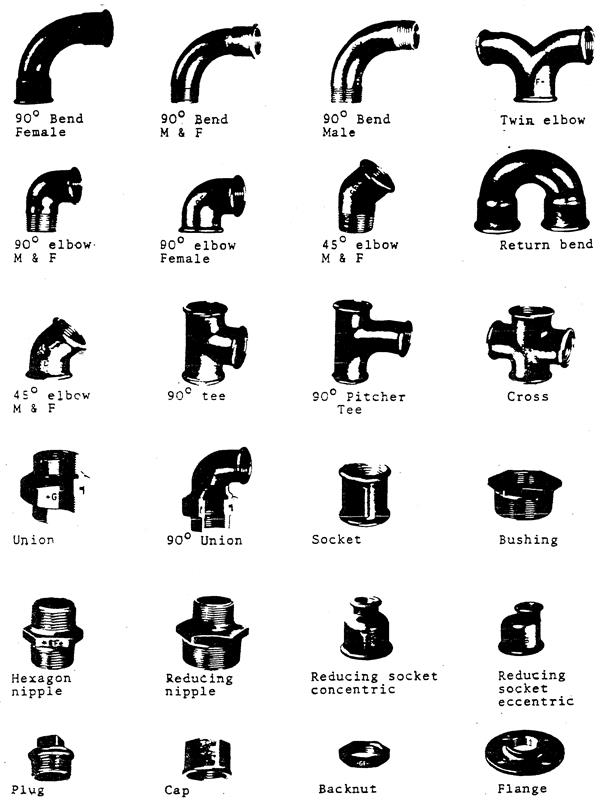
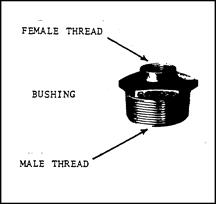
The threads on malleable iron pipe fittings are referred to as either male or female. The male thread is the one where the threads are external and visible. The female thread is the one where the threads are internal and hidden.
When ordering malleable iron tees with unequal outlets quote the size in the order shown in the figure opposite. So the correct way to quote the tees piece shown is: 25mm X 15mm X 20mm.

The Z dimension is the distance from the centre of the fitting to the point reached by the end of the pipe when it has been screwed the proper distance into the fitting.
When piping runs are being prefabricated it is essential to know this dimension and it can be obtained from the fitting manufactures catalogue.


Thread seals and taps are always applied in a clockwise direction when facing the threaded end of the pipe.
Polishing brass and chrome plated threads such as radiator valve tailpieces and bib taps may need to be slightly serrated with a hacksaw blade to give the flax or thread tape a grip.
If this is not done the flax of tape will move along the threads as the fitting is tightened leaving none in the joint and probably causing the joint to leak.
BOSS WHITE AND FLAX:
Is suitable for hot and cold water services and low pressure hot water heating.
P.T.F.E TAPE:
Is suitable for all the above mentioned applications as well as joints on oil and gas lines and oxygen and acetylene.
STAG JOINTING COMPOUND:
Is especially suitable for oil and gas lines.
The teeth on a hacksaw blade are set at a slight angle to enable the blade to produce a cut wide enough so that the rest of the blade does not bind or break.
It is important that the hacksaw blade being used is suitable for the type of material being cut.
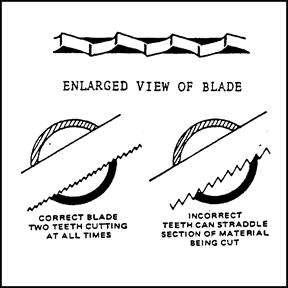
For rapid cutting of mild steel pipes a pipe cutters is used. It consists of cutting wheel, two guide rollers and an adjusting screw. The cutting wheel should be replaced periodically as a blunt wheel tends to crush rather than cut the pipe.
Pipe cutters with three cutting wheels are available for applications where the cutters can not be turned completely around by the pipe.
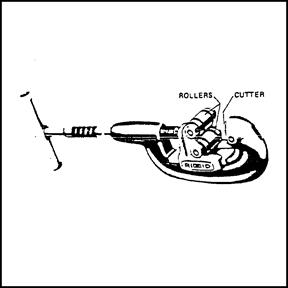
A pipe reamer is used to remove the internal burr left by the pipe cutter.
If this burr is not removed it causes an increased restriction to the flow of water in the pipeline.

The type of thread normally used for connecting mild steel pipes is called a British Standard Pipe Thread or B.S.P.T.
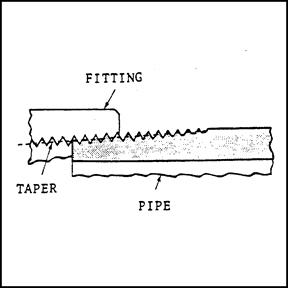
To cut threads on mild steel pipes a “stocks and dies” is used. This consists of a set of four dies in a holder. This holder fits into a ratchet stock which is fitted with a handle.
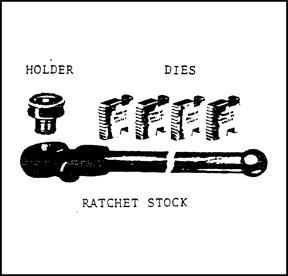
To cut a longscrew thread the normal thread cutting procedure is continued until the backnut and socket can be threaded completely on to the pipe.
Barrel nipples can be cut with a special attachment on the electric powered threading machine.
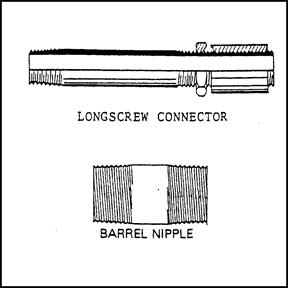
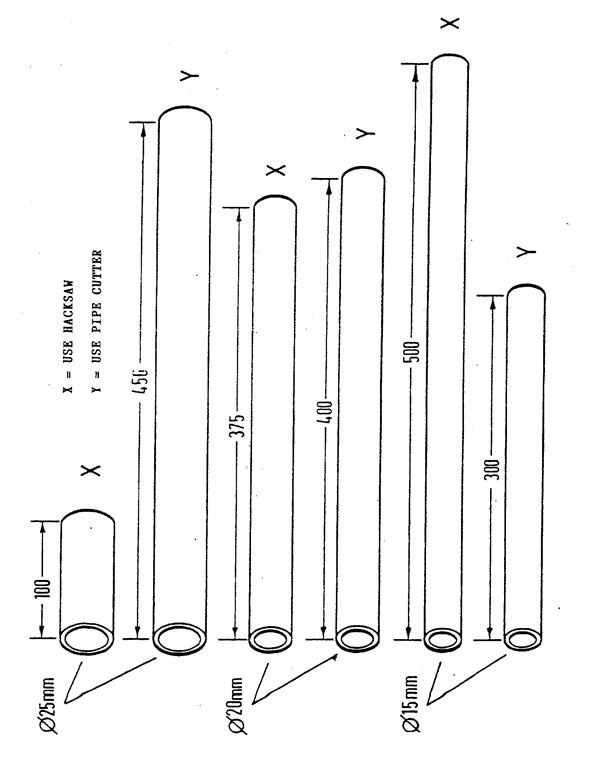

Pure water is a transparent, tasteless and odourless liquid.
It is a chemical compound composed of two parts hydrogen and one part oxygen (H2 O) and exists as a vapour, liquid or solid depending upon the pressure and temperature it is exposed to.
Water is essential to all forms of life and is generally classified as being either hard or soft.
Water has height, but this varies according to its temperature. This fact is important in the design and installation of plumbing and central heating systems. For example, it may effect the placing of taps, for the weight of the water combined with its height above the tap will affect the rate of flow.
For normal everyday purposes, and for simple calculations of forces and pressures, the weight of water is taken to be 1,000kg / m².
The following points are also worth noting:
Characteristics of water:
Boiling point |
100ºC |
Freezing point |
0ºC |
Maximum density |
4ºC |
Specific gravity |
1 |
The maximum density temperature of water is 4ºC.
Most materials expand as their temperature rises, and water expands when heated above this temperature. It is unusual, however, in that it also expands when cooled below this temperature.
Pure water boils at 100ºC at standard atmospheric pressure, and changes from a liquid to a gaseous state, expanding some 1,600 times as it does so. This gas is referred to as steam and has various applications in the plumbing industry. For example, steam may be used in large heating systems, or as a sterilising medium in hospitals, or even used as a source of power to drive a steam turbine.
Pure water freezes at 0ºC and changes from a liquid to a solid state called ice, with an immediate expansion of one tenth.
Thus, if the water in a 100mm tube were to freeze, all expansions were lengthways, the column of ice formed would be 110mm, or one tenth of the original volume of water, projecting beyond the end of the tube.
The force of this expansion is considerable, exerting great pressure on internal surfaces of pipes, which frequently burst under the strain. It is therefore very important that adequate precautions are taken to prevent damage to pipes by frost.
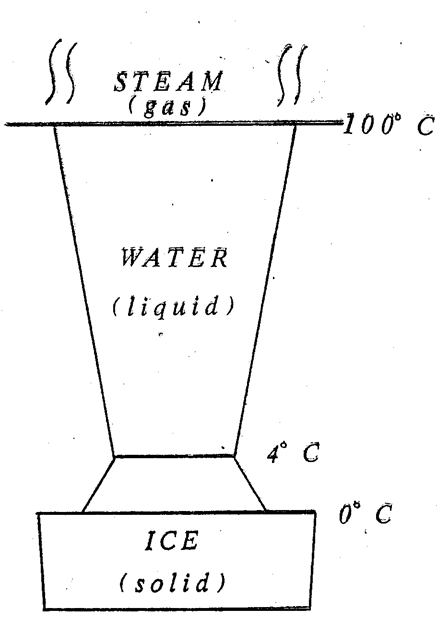

Pure water is the standard substance with which the weight and volume of all substances are compared.
Water is always shown with a specific gravity figure of 1. Any material with a specific gravity figure higher than 1 will sink in water, and any material with a specific gravity figure of less than 1 will therefore float.
Specific gravity may be defined as the ratio of the weight of a given volume of any substance to the weight of the same volume of water at 4ºC. The table below gives specific gravity figures and other relevant details of materials used in the plumbing industry.
MATERIAL |
CHEMICAL SYMBOL |
SPECIFIC |
MELTING POINT |
Water |
H2O |
1.0 |
100 |
Lead |
Pb |
11.3 |
327 |
Copper |
Cu |
8.9 |
1,000 |
Aluminium |
Al |
2.7 |
660 |
Cast Iron |
Fe |
7.2 |
1,526 |
Steel |
Fe |
7.8 |
1,926 |
It is worth nothing that specific gravity figures not only make it possible to compare the weight of a substance with water; they also make it possible to compare the weights of substances with each other. For example the specific gravity of lead is 11.3 while that of aluminium is 2.7 therefore, lead is approximately four times heavier than aluminium.
Water |
1 |
Lead* |
11.3 |
Aluminium |
2.7 |
Cork** |
0.15 |
Polystyrene |
0.015 |
*Lead is approx. 4 times heavier than aluminium.
**Cork is 10 times heavier then polystyrene.
Source: http://local.ecollege.ie/Content/APPRENTICE/liu/Plumbing_notes/Mild_Steel_Pipe_Preparation_Jointing_M1_U6.doc
Web site to visit: http://local.ecollege.ie/
Author of the text: indicated on the source document of the above text
If you are the author of the text above and you not agree to share your knowledge for teaching, research, scholarship (for fair use as indicated in the United States copyrigh low) please send us an e-mail and we will remove your text quickly. Fair use is a limitation and exception to the exclusive right granted by copyright law to the author of a creative work. In United States copyright law, fair use is a doctrine that permits limited use of copyrighted material without acquiring permission from the rights holders. Examples of fair use include commentary, search engines, criticism, news reporting, research, teaching, library archiving and scholarship. It provides for the legal, unlicensed citation or incorporation of copyrighted material in another author's work under a four-factor balancing test. (source: http://en.wikipedia.org/wiki/Fair_use)
The information of medicine and health contained in the site are of a general nature and purpose which is purely informative and for this reason may not replace in any case, the council of a doctor or a qualified entity legally to the profession.
The texts are the property of their respective authors and we thank them for giving us the opportunity to share for free to students, teachers and users of the Web their texts will used only for illustrative educational and scientific purposes only.
All the information in our site are given for nonprofit educational purposes